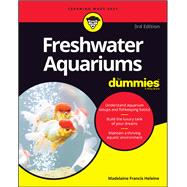Give your underwater pets the best aquatic life ever!
Aquarium fish are one of the most popular pets in America, with close to 150 million fish owned in nearly 13 million households. They seem like easy pets to care for, but there’s more than meets the eye when it comes to keeping your freshwater friends healthy and happy!
Inside, you’ll find basic information to start your own freshwater aquarium, purchase and maintain healthy fish and plants, and find tips and tricks on how to introduce new fish and systems into your aquatic family.
- Understand the best aquarium set-up practices
- Build the luxury tanks of your dreams
- Maintain a thriving aquatic environment
- Discover many different ways to expand your hobby
Perfect for beginner hobbyists and longtime aquarium enthusiasts alike, Freshwater Aquariums For Dummies makes it easier than ever to set up and take care of a freshwater aquarium—and the fish within it.








